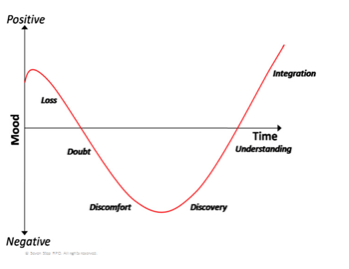RPO Change Management: What to Expect in the First 120 Days

So, What Can You Expect?
There are four definitive phases in the first 120 days:
Phase 1 – Learn
In this first phase, everyone’s energy is high, people are excited, and a few people are upset by the change, but overall, everyone is doing their best to get along and giving each other the benefit of the doubt. Issues and escalations are expected and resolved quickly. People understand that competency is low as everyone is getting used to new processes and new people.
Phase 2 – Optimize
Energy remains high, and people are starting to get more competent in using the new processes. Issues start to decrease, but they also start to go unreported (warning!). Frustrations occur as things are moving along, because not everyone is up to speed yet.
Phase 3 – Measured and Consistent
This is the toughest phase. I always tell people “you’re going to get mad at me” (why don’t they ever believe me?!). People are getting tired of the change. Everyone expects everyone else to be thoroughly trained and up to speed in performance. Issues that went unreported in Phase 2 explode on the scene as major issues. In fact, it is almost predictable that at least one major issue will erupt that will cause a review of the team makeup and drive changes to the team or process.
Phase 4 – Scale
Finally, everyone loves each other again. With adjustments made to the team and process, this is where things start to move along smoothly. People demonstrate high competence, consistent wins bring new energy, and people address escalations as they occur. The team feels positive because it is the right size and structure.
Now You Know — but How Do You Prepare for It?
I like to talk a lot about the difference between process (when you do visioning, charting, change teams, planning, and endless Powerpoint presentations) and communication. Communication is when you give people multiple opportunities to share concerns, ask questions, and offer ideas. Then, you make following up with answers and updates a top priority.
People won’t care about the change or transition success unless they know right away what is in it for them. So, you must clearly articulate how the change will benefit them in real terms and set realistic expectations. Designate a communications coordinator who will ensure that people are informed and given the opportunity to discuss changes.
Questions that need to be openly addressed include:
- What exactly is changing? From what to what?
- What does this change mean for what I do and how I operate on a daily basis?
- Will this make a difference? How?
- How will success be measured?
- Where do I go to find more information?
Covering these questions upfront is essential to making sure people understand their roles in the change.
Equally important is understanding and preparing people for the emotional journey that people will experience.It’s important to note that you will need patience and the willingness to change. Without them, you’ll just be spinning your wheels. Remind people of this on a regular basis. People’s emotions will rise and fall in a predictable pattern that correlates with the four phases, as outlined in the chart below:

Lastly, planning for success requires that communication and buy-in take place among stakeholders. You need to address the critical questions outlined earlier and, at the same time, avoid saturating people with too much communication. Keep stakeholders informed of the current state of the process, and provide point people who will be responsible for sharing real-time information on the transition. A clear escalation process and regular check-ins are also essential components. And finally, it helps to remind people that the four phases are normal parts of change. Once phase four is reached, life will get a whole lot easier, and the rewards will make it worth all the effort.

